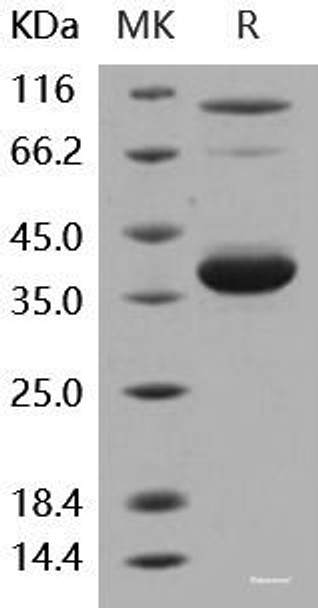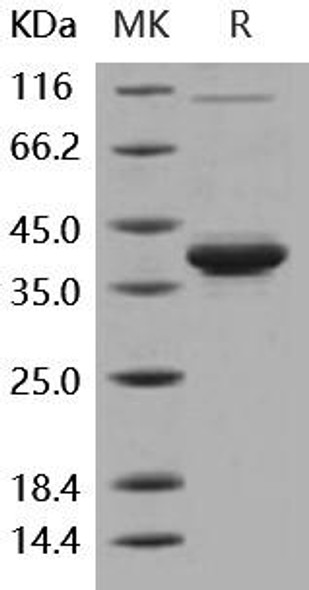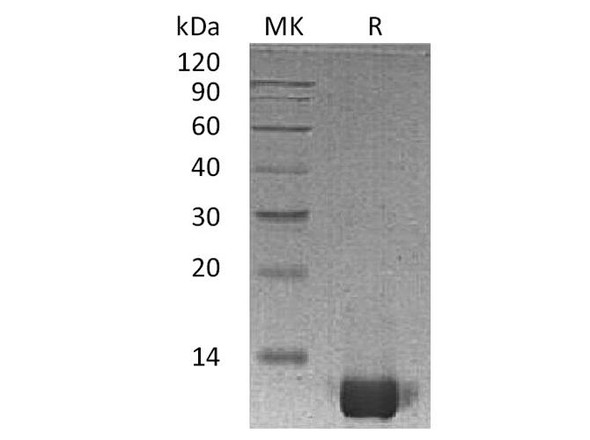Description
| Product Name: | Human IL-8/CXCL8 Recombinant Protein (aa 28-99, Fc Tag) |
| Product Code: | RPES6165 |
| Size: | 100µg |
| Species: | Human |
| Expression Host: | HEK293 Cells |
| Synonyms: | Interleukin-8, IL-8, C-X-C Motif Chemokine 8, Emoctakin, Granulocyte Chemotactic Protein 1, GCP-1, Monocyte-Derived Neutrophil Chemotactic Factor, MDNCF, Monocyte-Derived Neutrophil-Activating Peptide, MONAP, Neutrophil-Activating Protein 1, NAP-1, Protein 3-10C, T-Cell Chemotactic Factor, GCP1, IL8, Interleukin-8, LECT, LUCT, LYNAP, MDNCF, MONAP, NAF, NAP-1, NAP1 |
| Mol Mass: | 35 kDa |
| AP Mol Mass: | 40 kDa |
| Tag: | N-hFc |
| Purity: | > 90 % as determined by reducing SDS-PAGE. |
| Endotoxin Level: | < 1.0 EU per μg of the protein as determined by the LAL method. |
| Bio Activity: | Testing in progress |
| Sequence: | Ser 28-Ser 99 |
| Accession: | NP_000575.1 |
| Storage: | Generally, lyophilized proteins are stable for up to 12 months when stored at -20 to -80°C. Reconstituted protein solution can be stored at 4-8°C for 2-7 days. Aliquots of reconstituted samples are stable at < -20°C for 3 months. |
| Shipping: | This product is provided as lyophilized powder which is shipped with ice packs. |
| Formulation: | Lyophilized from sterile 100mM Glycine, 10mM NaCl, 50mM Tris, pH 7.5 Normally 5 % - 8 % trehalose, mannitol and 0.01% Tween80 are added as protectants before lyophilization. Please refer to the specific buffer information in the printed manual. |
| Reconstitution: | Please refer to the printed manual for detailed information. |
| Background: | Interleukin 8 (IL-8), also known as CXCL8, which is a chemokine with a defining CXC amino acid motif that was initially characterized for its leukocyte chemotactic activity, is now known to possess tumorigenic and proangiogenic properties as well. This chemokine is secreted by a variety of cell types including monocyte/macrophages, T cells, neutrophils, fibroblasts, endothelial cells, and various tumor cell lines in response to inflammatory stimuli. In human gliomas, IL-8 is expressed and secreted at high levels both in vitro and in vivo, and recent experiments suggest it is critical to glial tumor neovascularity and progression. Levels of IL-8 correlate with histologic grade in glial neoplasms, and the most malignant form, glioblastoma, shows the highest expression in pseudopalisading cells around necrosis, suggesting that hypoxia/anoxia may stimulate expression. Accumulating evidence has demonstrated that various types of cells can produce a large amount of IL-8/CXCL8 in response to a wide variety of stimuli, including proinflammatory cytokines, microbes and their products, and environmental chang. Numerous observations have established IL-8/CXCL8 as a key mediator in neutrophil-mediated acute inflammation due to its potent actions on neutrophils. The discovery of these biological functions suggests that IL-8/CXCL8 has crucial roles in various pathological conditions such as chronic inflammation and cancer. |






